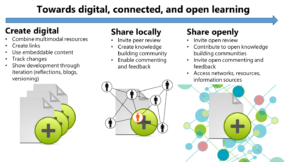
Photo by Michael Paskevicius on digital, connected, and open learning
How can educators effectively build relationships by encouraging safe communication and interactions in online & open learning spaces?
Educators can effectively build relationships by taking advantage of the fact that many students increase their interactions when in an online situation rather than a traditional classroom. The online and learning space settings are unlikely to deter the vociferous or outspoken students to retract into themselves while the shyer student will find the online environment to be not as daunting or threatening. The educator therefore has a greater opportunity to exploit the full talents of all the class in a classroom that provides anonymity.
Too many students never read all the small print in the university rules and regulations, until they find themselves in difficulties. Already in this course the students have been directed to thorough reading of the rules governing personal information and privacy as indicated in the British Columbia’s Freedom of Information and Privacy Protection Act (FIPPA). The ethical issues concerning information privacy; anonymity; surveillance; autonomy; non-discrimination; and ownership of information as outlined by Regan and Jesse (2019), should be discussed. This simple quiz formula in our first assignment and exercises like this makes the student research, realize and understand their full rights and this builds trust which is the key of any relationship. Once the student feels secure they are more likely to open up.
Even before the building of relationships by encouraging safe communication and interactions in online & open learning spaces is considered by the educators, they should also monitor the progress of all the participants to make sure that they are not struggling with the logistics and technology to participate in the course, as the student will not wish to admit facing early difficulties, as it could be seen as failure to perform tasks or an admission of weakness.
In the online and open learning setting it is important to remember as Donne said “No man is an island entire of itself” (Domme, 1962). Cyberspace can be a lonely place but technology offers ease to communicate and perform group projects which encourage interaction. Classroom relationships are restricted to a few hours per week but online learning allows continuous opportunity to develop relationships as opposed to meeting the educator and fellow students say every Monday, Wednesday and Friday between 9am and 11am.
To conclude the best options for educators to build relationships by encouraging safe communication and interactions in online & open learning spaces are to firstly provide a suitable environment, to explain precisely the mechanics of the technology to ensure instructors and students are all on the same page, and finally through encouraging research group activity and quizzes and assignments, to allow the student learn how safe and secure the environment really is. The setting should be easier to integrate the whole class and encourage interaction as opposed to a classroom setting.
What did you already know, what do you know now based on the course readings and activities?
I had not really given online and open learning spaces a lot of thought outside of the fact that they were a useful tool as my educational career progresses. When the pandemic began back in early 2020 I recall predicting a boom in the field due to prevailing circumstances. My thoughts on the subject were based on practical thinking. But once the course I began to think of the ethical issues such as tracking, ownership of personal information. I had not considered the philosophy associated with technology and education.
Not only did the readings encourage me to read the FIPPA for the first time, I learned that the words “custody” and “control” are not defined as per the act, but on a serious note I got a full grip on what is classified as personal information and the individual rights that surround it. Nam Jun Paik in Howell Major (2015) states that “Skin has become inadequate in interfacing with reality. Technology has become the body’s new membrane of existence” (p. 9). This reading exercise describes technology’s role in education as; technology as context, as an extension of the self, as in interpretive lens and finally as a humanlike interface. This provides a lot of food for thought.
I also had not considered the teacher’s perspective as outlined in Howell Major (2015), I found educators such as Eloise Tan’s views very interesting when they discussed the problems they faced with the growth of online and open learning spaces ranging from initial nervousness to self-questioning on whether they could do it and had the necessary skills.
What do I hope to learn?
The short answer is I hope to learn a lot, as in the case of weeks 1&2. The course has got me thinking of questions such as what does research show in terms of the success of online and open learning as opposed to the success rates of students in the classroom setting. What are the external effects of online and open learning spaces on the student in terms of time spent using technology, does it cause addictions or abuses in that students spend a lot of time already interacting online and gaming online. How far can it go and what will the saturation point be and when will it be reached. Not all countries have the infrastructure to set up such education and will this increase the gap between the developed and developing worlds. Even internally in Canada and the U.S. will this new educational technology cause divisions if equal facilities cannot be afforded to all students?
References
Donne, J. (1962). Meditation XVII: devotions upon emergent occasions. Sermons of John Donne, 7, 369.
Howell Major, C. (2015). Teaching Online – A Guide to Theory, Research, and Practice. (Chapter 1). Retrieved from http://ebookcentral.proquest.com/lib/uvic/detail.action?docID=3318874
Regan, P. M., & Jesse, J. (2018). Ethical challenges of edtech, big data and personalized learning: twenty-first century student sorting and tracking. Ethics and Information Technology. doi:10.1007/s10676-018-9492-2